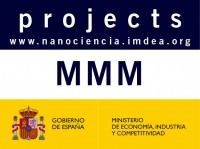MMM Machines and Materials based on Mechanically Interlocked Nanotubes
Prof. Emilio M. Pérez
-
Funding : Ministerio de Economía y Competitividad. Programa Excelencia 2013-2016. CTQ2014-60541-P
-
Duration: 2015 - 2017
-
36 months
Our group has recently described the synthesis of mechanically interlocked derivatives of single wall carbon nanotubes (MINTs). MINTs are rotaxane-type species where the single-wall nanotubes (SWNTs) act as threads, which are encapsulated by macrocycles formed around them through ring closing metathesis, following a “clipping” strategy. To ensure a template effect, we incorporated two exTTF units as recognition motifs for the SWNTs in the linear precursors to the macrocycles. The objectives of this project are:
The first objective will be tackled by maintaining the initial design for the macrocycle precursors introducing variation in the SWNT recognition fragment only. In particular, we will focus our attention on pyrene, naphthalene and perylene diimides, and porphyrins. To synthesize a common building block for multifunctional materials, we will introduce alkyne or azide functionalities in the structure of the macrocycle precursors. To the properly functionalized MINT building block, we will “click” molecular hosts (for sensors), catalysts, or photoactive molecules (solar cells). Finally, to investigate the submolecular motion of the macrocycle(s) along the SWNT thread in MINTs, we will follow two different approaches to suspend the MINTs, which in turn imply different methods of controlling and visualizing the movement. Firstly, we will utilize surfaces patterned at the nanoscale, on which we will directly deposit the MINT materias through drop-casting. In this case, AFM will be the main tool to control and observe the motion. Alternatively, we will deposit the MINTs between two metallic electrodes, which will be constructed through standard nanofabrication techniques. In this case, differences in the I/V curves will be used both to provoke and monitor the submolecular motion. Whenever possible, we will also use SEM and/or AFM.
http://nanociencia.imdea.org/images/nanociencia/scientific_reports/Scientific-Report-2016.pdf#page=162




